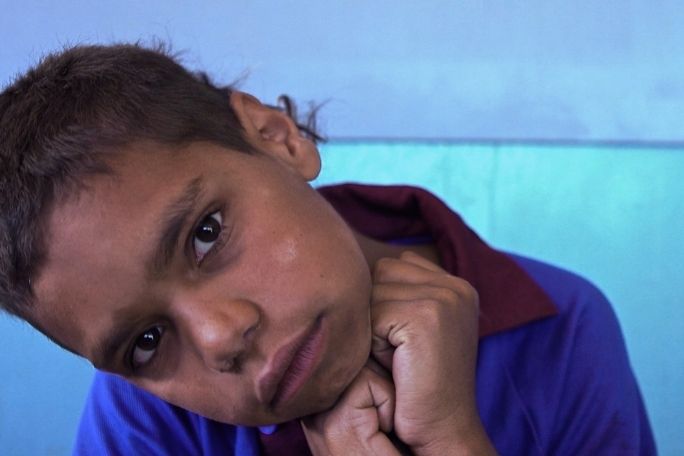Lesson summary
In this lesson, students will explore a key theme from the feature documentary In My Blood It Runs; that is, how diverse perspectives are taught and treated in the classroom. Focusing on two clips from the film, students will have the opportunity to reflect on their own perspectives, where these come from and how those perspectives might influence how they interpret ‘Australian history’.
Learning intentions:
Students understand...
- why people from different backgrounds might have different perspectives on history
- more about their own perspectives, how they are formed and how they might be expanded
- how different perspectives can be represented and explored in film
Success criteria:
Students can...
- identify film techniques used to portray different perspectives
- contribute sensitively to small group and class discussions
- critically reflect on their own perspective and point of view
Lesson guides and printables
Curriculum links
Select your curriculum from the options below.
Lesson details
Curriculum mapping
Australian curriculum content descriptions:
Year 9 English:
- Explore and reflect on personal understanding of the world and significant human experience gained from interpreting various representations of life matters in texts (ACELT1635)
- Investigate and experiment with the use and effect of extended metaphor, metonymy, allegory, icons, myths and symbolism in texts, for example poetry, short films, graphic novels, and plays on similar themes (ACELT1637)
- Analyse how the construction and interpretation of texts, including media texts, can be influenced by cultural perspectives and other texts (ACELY1739)
- Interpret, analyse and evaluate how different perspectives of issue, event, situation, individuals or groups are constructed to serve specific purposes in texts (ACELY1742)
- Explore and explain the combinations of language and visual choices that authors make to present information, opinions and perspectives in different texts (ACELY1745)
Year 10 English:
- Analyse and explain how text structures, language features and visual features of texts and the context in which texts are experienced may influence audience response (ACELT1641)
- Identify, explain and discuss how narrative viewpoint, structure, characterisation and devices including analogy and satire shape different interpretations and responses to a text (ACELT1642)
- Analyse and evaluate how people, cultures, places, events, objects and concepts are represented in texts, including media texts, through language, structural and/or visual choices (ACELY1749)
- Evaluate the social, moral and ethical positions represented in texts (ACELT1812)
Syllabus outcomes: EN5-2A, EN5-3B, EN5-4B, EN5-7D, EN5-8D
General capabilities: Critical and Creative Thinking, Personal and Social Capability, Intercultural Understanding
Cross-curriculum priority: Aboriginal and Torres Strait Islander Histories and Cultures (OI.3, OI.5, OI.6)
Relevant parts of Year 9 & 10 achievement standards: Students interpret, create, evaluate, discuss and perform a wide range of literary texts in which the primary purpose is aesthetic, as well as texts designed to inform and persuade. These include various types of media texts, including newspapers, film and digital texts, fiction, non-fiction, poetry, dramatic performances and multimodal texts, with themes and issues involving levels of abstraction, higher order reasoning and intertextual references. Students develop a critical understanding of the contemporary media and the differences between media texts.
This lesson is part of the wider unit of work In My Blood It Runs
Time required: 65 mins
Level of teacher scaffolding: High – facilitate class activities and discussions, maintain a safe environment for all students
Resources required
- Device with internet access capable of displaying videos for the whole class
- Student Worksheet
Skills
This lesson is designed to build students’ competencies in the following skills:
- Critical thinking
- Cultural understanding
Additional info
We recommend that you teach this lesson, and/or the first lesson in this sequence, Identity, before showing the full film to your class. To help study the film, we strongly encourage you to access the free professional learning resource, which has been co-developed by Reconciliation Australia’s Narragunnawali team. You should also view the full-length documentary prior to your planning around these resources.
Cool Australia would like to thank the In My Blood It Runs Advisory Committee who supported the writing of this resource. Special thanks to Alanna Raymond, Tessa Keenan, Stephanie Woerde, Esma Livermore and Julie Bover from Reconciliation Australia, Alex Shain from Shark Island, Maria Katsabanis from Australian Human Rights Commission, Renee Phillips from National Indigenous Youth Education Coalition, and Keren Shlezinger.


Welcome back!
Don't have an account yet?
Log in with:
Create your free Cool.org account.
Many of our resources are free, with an option to upgrade to Cool+ for premium content.
Already have an account?
Sign up with:
By signing up you accept Cool.org's Terms and Conditions(Opens in new tab) and Privacy Policy(Opens in new tab).